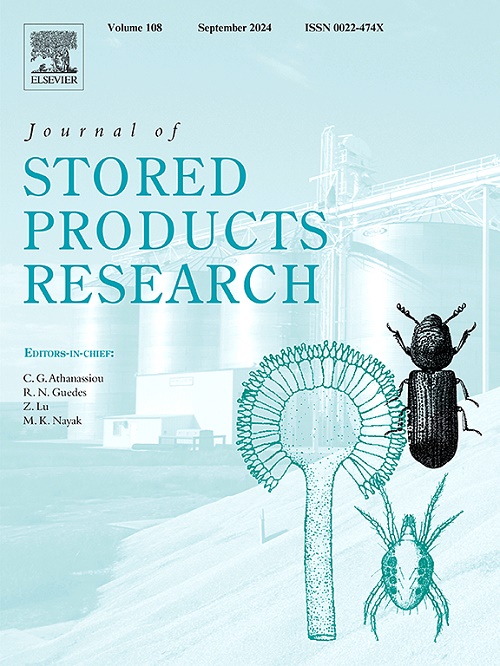Effect of different sub-zero temperatures and relative humidities on moisture content and germination of stored canola
IF 2.7
2区 农林科学
Q1 ENTOMOLOGY
引用次数: 0
Abstract
Storage of high-moisture canola remains a major challenge due to mold growth resulting in seed deterioration. While equilibrium moisture content (EMC) models have been widely applied to above-zero storage and drying conditions, no research has quantified EMC isotherm and germination under sub-zero temperatures. Isotherm and germination of canola, conditioned to 14–18 % moisture contents, were tested at temperatures from −25 to +30 °C and relative humidities (RHs) between 15 and 94 %. Multiple EMC models were evaluated for their predictive accuracy across the studied temperatures and RHs. The main factor influencing EMC of canola from −5 to −20 °C was the RH, and temperature had minimal influence. Both temperature and RH influenced the EMC when temperature was −20 °C. When RH was higher than 75 %, EMC of canola had an exponential increase with the increase of RH and/or decrease of temperatures. Seed germination remained high (≥80 %) at −5 to −15 °C, and RH had a minimum influence on the germination. At −20 and −25 °C and higher than 40 % RH, canola germination was reduced to less than 40 % after EMC was reached, indicating severe damage to the canola seeds. Peleg model yielded the best fit to the isotherm data at different sub-zero temperature ranges. These findings offer essential guidance for sub-zero grain storage and drying strategies, with implications for preserving seed viability and reducing post-harvest losses.
不同零度以下温度和相对湿度对贮藏油菜籽含水量和发芽的影响
由于霉菌生长导致种子变质,高水分油菜籽的储存仍然是一个主要挑战。平衡含水率(EMC)模型已广泛应用于零度以上的贮藏和干燥条件下,但还没有研究对低于零度的温度下的EMC等温线和发芽进行量化。在温度为- 25 ~ +30℃,相对湿度(RHs)为15% ~ 94%的条件下,对14 ~ 18%含水量的油菜籽进行了等温和萌发试验。评估了多个EMC模型在研究温度和RHs范围内的预测精度。在−5 ~−20℃范围内,影响油菜籽EMC的主要因素是相对湿度,温度的影响最小。当温度≤- 20℃时,温度和相对湿度对电磁兼容都有影响。当相对湿度大于75%时,油菜的EMC随相对湿度的增加和温度的降低呈指数增长。在−5 ~−15℃条件下,种子萌发率保持较高(≥80%),RH对萌发的影响最小。在- 20°C和- 25°C,高于40% RH条件下,达到EMC后,油菜籽的发芽率降至40%以下,表明油菜籽受到严重损害。在不同的零下温度范围内,Peleg模型对等温线数据的拟合效果最好。这些发现为零下粮食储存和干燥策略提供了重要指导,对保持种子活力和减少收获后损失具有重要意义。
本文章由计算机程序翻译,如有差异,请以英文原文为准。
求助全文
约1分钟内获得全文
求助全文
来源期刊
CiteScore
5.70
自引率
18.50%
发文量
112
审稿时长
45 days
期刊介绍:
The Journal of Stored Products Research provides an international medium for the publication of both reviews and original results from laboratory and field studies on the preservation and safety of stored products, notably food stocks, covering storage-related problems from the producer through the supply chain to the consumer. Stored products are characterised by having relatively low moisture content and include raw and semi-processed foods, animal feedstuffs, and a range of other durable items, including materials such as clothing or museum artefacts.

 求助内容:
求助内容: 应助结果提醒方式:
应助结果提醒方式:


